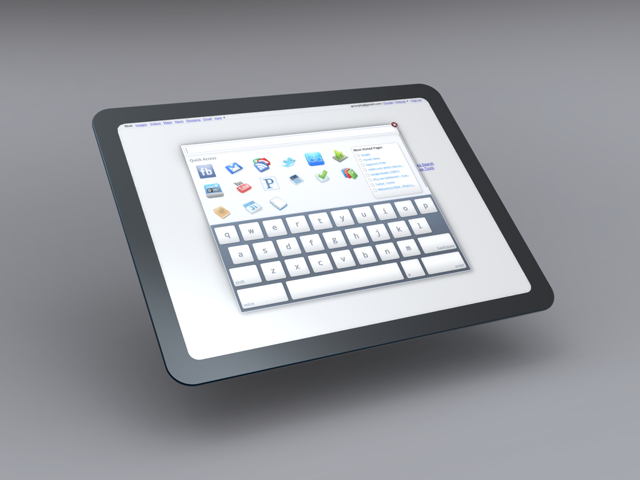Officially, Google won’t confirm any solid plans to release a tablet device when their new netbook-ready operating system, Chrome OS, debuts later this year. However, documentation appearing recently on the Chromium project website, the home of the open source code on top of which Chrome is built, shows that a tablet PC is a form factor the Internet giant is definitely considering. Assuming such a device was ever to launch, it would pit Google’s vision for the future of mobile computing up against that of Apple’s iPad, the highly-anticipated multi-touch tablet launched late last month to mixed reviews.

While both the Apple slate and the possible Google Chrome tablet tout sleek and shiny elegance on the outside, the two computing devices could not be more different on the inside. And when it comes time to buy, consumers will have to make a choice: what sort of tablet is the future of computing? Apple’s locked-down and closed ecosystem of apps running on proprietary hardware or Google’s browser-based OS that’s as open as the web itself?
Concepts for the Google Tablet
Before we get ahead of ourselves here, it’s important to clarify one thing: these mockups and design schematics do not confirm the existence of a Google tablet computer. Posted to the official Chromium site by Google Chrome designer, Glen Murphy, they only represent concepts Google may be considering for their new operating system.

That being said, it wouldn’t be a surprise if one or more of the upcoming “Google computers” were in the shape of a slate. Considering the buzz Apple’s iPad has generated, Google won’t have to sell the idea of tablet computing to the general public. They’ll just have to convince consumers that their tablet is the better alternative.
Still, because nothing is officially confirmed, the arguments below are hypothetical in nature, pitting the iPad against a possible Google tablet computer.
Why Buy Google’s “iPad?”
So how will Google convince the buying public to choose their tablet over the iPad? Two things immediately come to mind. The first, of course, is price. Although the low-end of the iPad line is a reasonable $499, models with additional storage or 3G connections make the iPad much pricier – pushing $800 for the high-end devices. Google, meanwhile, can sell their OS on a number of form factors via a number of hardware partners (HTC is rumored as being the initial Google tablet partner). That will allow Google to price some models competitively with Apple’s iPad, if not beat iPad prices entirely.
More importantly, though, Google’s tablet will have one major advantage over Apple’s iPad: it will have an open application platform.
The only problem is getting consumers to understand what being open means…and care. Where Apple’s iPad will be restricted to running approved applications from the iTunes App Store – a business model that has raised flags when Apple’s app overlords blocked popular, rival apps from their store (most notably, Google Voice) – the model has proved incredibly successful for the Cupertino-based company. The iPhone OS is the most popular smartphone OS in the world with Google’s mobile Android OS trailing further behind. Although Google’s mobile offering is far more open, consumers have – so far – voted with their wallets, choosing Apple’s restrictive “we’ll think for you” mobile OS and accompanying ecosystem over Google’s “do what you want” alternative.
Although that concept may work when it comes to our mobiles, tablet computing may find consumers…well…thinking differently.


Apple’s Vision Includes the Web
A tablet computer is more like a netbook than a mobile phone and when people use a netbook, they expect to be able to use – you guessed it – the net. But this is where Apple’s vision may fail – at least for now. For whatever reason, Apple doesn’t allow for Flash content on their iPad. Some say this has to do with the CPU-hungry runtime that negatively affects PC performance while eating away at precious battery life, others claim that Flash simply isn’t an “elegant” enough solution for Apple, and still others claim that it has to do with personal rivalries between the two companies. But no matter what the real truth is, consumers won’t care. Once they find out that video websites like YouTube don’t work on the iPad, news sites like CNN lack video, and the TV portal Hulu is beyond reach, the iPad will, in their eyes, just NOT work.
Meanwhile, Google’s Chrome OS will. It will provide access to the real web…and all its buggy code. And while that might degrade the battery’s performance on a Chrome PC, consumers won’t care so much because they’ll be able to finally watch that new episode of “30 Rock.”
But What about HTML5?
None of this is to say that supporting Flash will or won’t be the final “make it or break it” decision when it comes to the selection of a new tablet PC. Ultimately, Flash will likely be phased out as the new web standard HTML5 is slowly phased in. With HTML5, videos will play smoothly, with no web plugin required. Already, YouTube is testing an HTML5 site, for example.

Still, Apple’s decision to veto Flash represents a philosophical difference between the two companies – Google would never intentionally “break” the web. But Apple has a vision for their devices, and if they don’t like how something is built, it won’t run on their hardware. Flash may only be the first casualty in this war. This means any future company developing new web standards or software will either have to work with Apple – as Microsoft did with their Silverlight runtime – or deal with the potential consequences of losing access to millions of mobile users.
Eventually, these differences will have consumers choosing between two “big brother” type figures: the one that watches your activities everywhere on the web and the one that wants to control what the web even is.

















